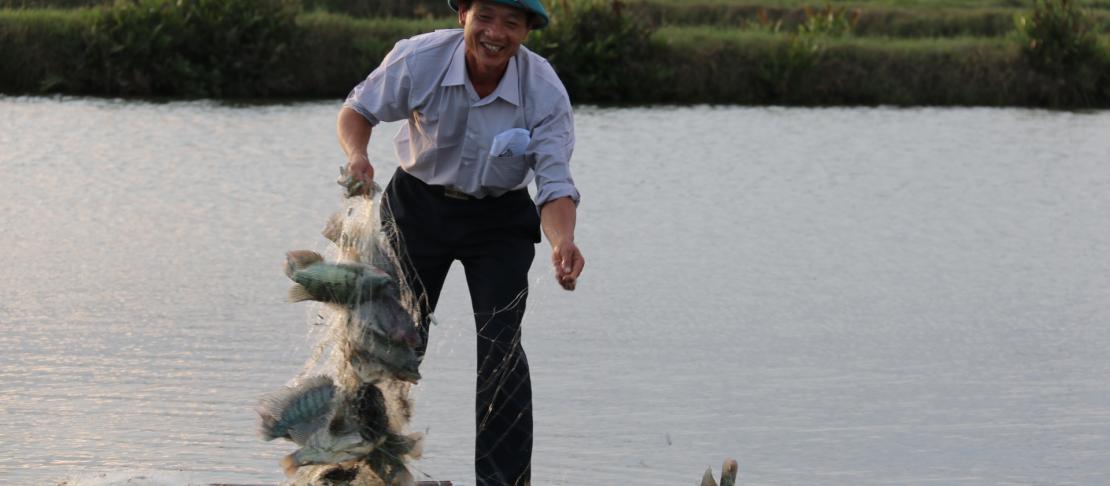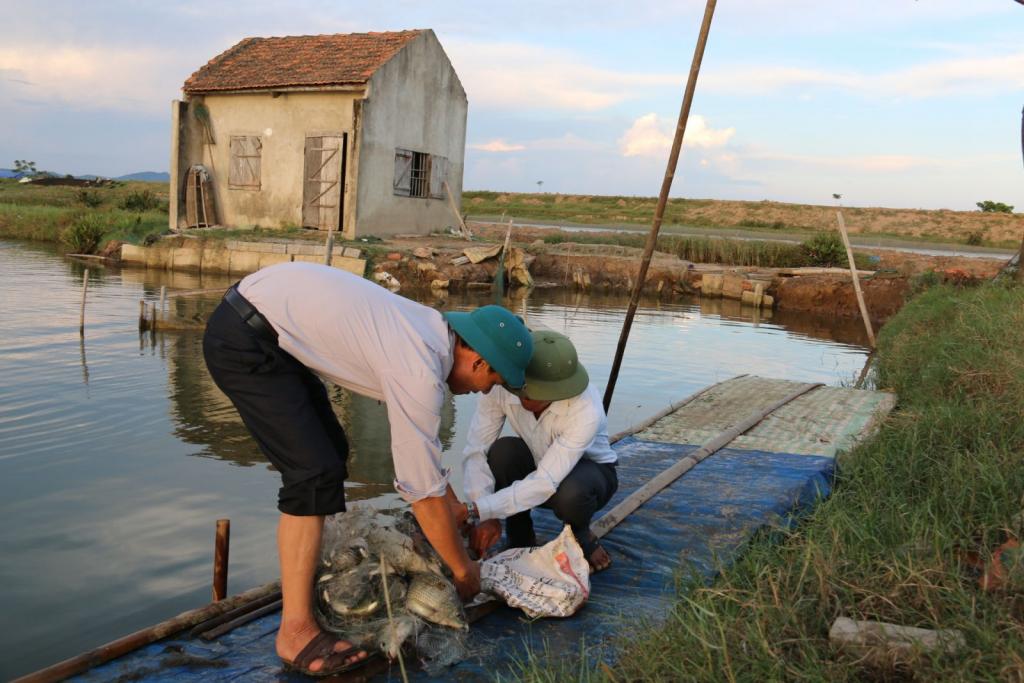Swimming towards adaptation with climate-smart aquaculture

The introduction of climate-smart aquaculture in Vietnam gave farmers better incomes through greater yields from brackish water shrimp ponds.
Climate-smart agriculture (CSA) has now reached farmers from the coastal commune of Hoang Phong in Thanh Hoa province, Vietnam.
From the former practice of stocking a local tilapia variety to feed on algae, thereby cleaning up shrimp ponds, farmers have started adding mono-sex tilapia into these ponds using integrated aquaculture systems under the “Enhancing community resilience to climate change by promoting smart aquaculture management practices along the coastal areas of North Central Vietnam (ECO-SAMP)” project.
Led by the WorldFish Center in collaboration with the CGIAR Research Program on Climate Change, Agriculture and Food Security (CCAFS) in Southeast Asia, Vietnam Institute of Fisheries Economics and Planning (VIFEP), and Thanh Hoa Extension Center, the first phase of the project started in February 2015 and will finish December 2016.
Aquaculture in the face of climate change
According to the Food and Agriculture Organization (FAO) of the United Nations, aquaculture is the fastest-growing food production sector globally. Future growth of aquaculture is essential to providing sustainable fish supplies, creating jobs, generating income for rural farmers and maintaining fish at affordable prices for resource poor consumers.
More specifically, Southeast Asian countries and the other 12 top aquaculture producers in the world have yielded around 90.8 out of 97.2 million tons of aquaculture produce in 2013. And production trend is projected to increase to more than 200 million tons worldwide in 2050.
Farmers in Hoang Phong commune usually grow tiger shrimp, mud crabs, and seaweed in brackish water shrimp ponds near the coast. Changes in temperatures and rainfall patterns and increases in extreme weather events result in negative impacts on aquaculture, communities, livelihoods and the economy, especially for Hoang Phong.
Aside from changes in climate and water availability, farmers also have to deal with the impacts of climate change on their cultures of shrimp, crabs, fish and seaweed. Although shrimps give higher profits to farmers, growing shrimp during months with salinity dropping below 5 parts per thousand (ppt) exposes farmers to high risks of crop failure, as shrimp do not grow well and become highly exposed to diseases. Thus, tilapia is a good alternative income source for farmers as these fish are generally more resilient.
Another issue that has to be dealt with is the growth of algae as it hinders the proper development of the cultured seaweed, fish, shrimps, and crabs. Farmers observed that local tilapia can clean their ponds of algae, so they started introducing the fish into the brackish water shrimp ponds. However, the local tilapia is small in size and, therefore, not commercially viable. Thus, the farmers only grew this for environmental and not economic purposes.
Greater incomes and greater resilience
The ECO-SAMP project aims to enhance the resilience of farmers in coastal communities in Hoang Phong through the development and promotion of climate-smart aquaculture practices,with appropriate organizational mechanisms of community-based management. A case in point is the use of mono-sex tilapia when environment conditions are not favorable for shrimp culture due to changing climate.
Truong Van Mien and Truong Van Nuong inspect and bag their harvest of tilapia. Farmers growing mono-sex tilapia in brackish water shrimp ponds spend less on inputs, increasing their incomes and food security. Photo: CCAFS/Amy Cruz
Mono-sex tilapia can still thrive in water with higher salinity, up to 15%, of 15 ppt, in the trial ponds, while feeding on the algae that cover the pond bottoms and on wastes from the shrimps. Farmers could also then reduce the amount of feeds given to the fish, and even save on labor for the regular clearing of algae.
Farm-scale trials have been established in the shrimp ponds of five farmers. Luong, a member of the commune management board, is one of the farmers ECO-SAMP has been working with. He says, “I estimate that I have gotten a 50% increase in my income with the integrated aquaculture system. From VND120 million [USD5349.60] per year, my income can increase up to VND180 million [USD8024.40].”
Aside from the five trials, the project team also conducted training workshops on climate-smart integrated farming, climate-smart aquaculture techniques, and farm budgeting with 125 farmers and local officers from the commune. Twenty farmers participated in a study tour of the climate-smart integrated farming system with red tilapia in Nam Dinh province.
The project also provides farmers with technical and financial guidance and possible solutions to environmental management and market issues. The farmers were connected with agencies that sell quality tilapia fingerlings and feed. They were also directed towards a market for their produce.
The future of fish
As the first trials within ECO-SAMP project is due to end December 2015, farmers involved are asking to scale out the technology to other households and communities. They suggested forming a service cooperative that would help provide quality fingerlings and feed for the members; however, this would need a relatively large capital source to set up. Connections with hatcheries and feed companies should also be established to directly bring these inputs to the farmers.
Another issue the farmers see, if most of the households would grow climate-smart mono-sex tilapia, would be the available markets for their produce. Without a market, their cultures would not be as profitable for them.
Despite these constraints, they still remain positive that this technology option will render them more resilient in light of climate change, and this should extend to more households and communities.
For more information, please contact Nhuong Tran (WorldFish) at n.tran@cgiar.org.
Read more:
- Linking pink shrimps, green mangroves and blue carbon
- Impacts of climate change on fisheries and women in Bangladesh
- If you can’t catch a fish, don’t blame the sea
Amy Cruz is the junior communications specialist for the World Agroforestry Centre Philippines. She is also a communication consultant with the CCAFS SEA program.




